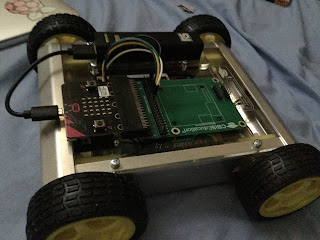Of course I had to play with it in Air mode, it is a drone I want to see it fly. But there options for creating hovercraft and your own designs.
It is controllable via an app either by directly controlling or through Makeblock's own block based programming language Makeblock both are in the same app which is a feature I particularly liked. It can be annoying have to multiple apps for the same product.
Selecting Air Mode (as below) means you can control it directly or chose New Project to program it.
Click on the button and you can drag blocks to program the drone. Take it out of design mode and it the appropriately name play mode and your are ready to go.
Great fun, but I struggle to control it (that is probably just me I do with most drones). When it hits anything the propeller units (prop, motor in polystyrene case, with a magnetic connector) do come away, as they are designed to do, for safety. A mistake I kept making was getting the propeller unit upside, but you quickly notice it - it goes all over the place. You will be playing 'hunt the prop' quite often when it crashes (and it will) they do seem to fly off.
Great fun to play with; now are available to order/pre-order (at the time of writing) at https://makeblockshop.eu/products/makeblock-airblock .
Related links:
mBot - cute, fun and Arduino based
It is a good time to play with little robots
All opinions in this blog are the Author's and should not in any way be seen as reflecting the views of any organisation the Author has any association with. Twitter @scottturneruon

























